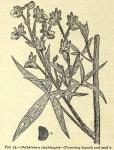 The ripe seed of Delphin'ium staphisag'ria Linné.
The ripe seed of Delphin'ium staphisag'ria Linné.
BOTANICAL CHARACTERISTICS.—Stem 3 to 4 feet high, erect, more or less colored purple; leaves long petiolate, alternate, palmately 5-9-divided, blotched with purple; flowers in loose spoke-like racemes, varying from light-blue to purple; irregular; sepals 5, petaloid, upper one prolonged into a spur; petals 4, small; fruit 3, hairy follicles.
SOURCE.—This herb is a native of Italy, Greece, the Greek Islands, Asia Minor, Mediterranean regions, and Canary Islands. It was introduced into England in 1596.
DESCRIPTION OF DRUG.—About 5 mm. (1/5 in.) long, 3 to 4 mm. (1/9 to 1/6 in.) thick; externally flattish, tetrahedral, the broadest side convex; testa brownish, with reticulate ridges, rough and deeply pitted; internally it contains a whitish, oily albumen, inclosing a small, straight embryo in its sharper end. The outer layer of the testa is made up of thin-walled, narrow cells, which become larger near the edges of the seed and in the. superficial wrinkles. They contain a small number of minute starch granules. The interior layer exhibits a single layer of small, densely-packed cells. The albumen is composed of the usual tissue loaded with granules of albuminoid matter and drops of fatty oil. Nearly inodorous; taste bitter and astringent. Dose 1 gr, (0.06 Gm.).
Powder.—Dark greenish. Characteristic elements: The angular cells of the parenchyma of the endosperm with aleurone and oil globules; very large epidermal cells, brown, thick-walled, with irregular thickenings.
CONSTITUENTS.—Resides fixed oil, etc., one of the most prominent constituents is a poisonous alkaloid, delphinine, which exists in the form of a malate. This alkaloid, however, is said to be composed of several distinct principles. Marquis has separated four distinct alkaloids from the seed.
Preparation of Delphinine.—Treat the decoction with magnesia, exhaust the precipitate with alcohol, and evaporate. The crude alkaloid thus obtained consists of three distinct principles-resin, staphisagrine, and delphinine. Pure delphinine is soluble in alcohol and ether.
ACTION AND USES.—Stavesacre is mostly used as a parasiticide to destroy vermin, especially against pediculi vestimentorum—inhabiting the garments next to the skin. A tincture in cologne spirit has been used in some districts as a substitute for tincture of Cocculus indicus, applied to the scalp as an antiparasitic. Internally, the action resembles aconite in its effects upon the heart and respiration. Dose: 1 to 2 gr. (0.065 to 0.130 Gm.). Poisonous doses are rapidly diffused, and antidotal measures should be rapidly applied. (Fluidextractum staphisagriae, used externally as a parasiticide.)

